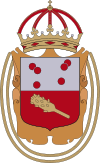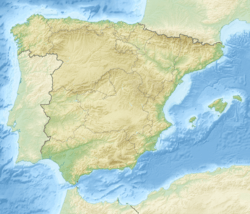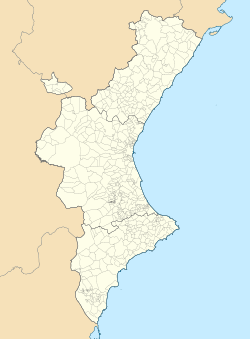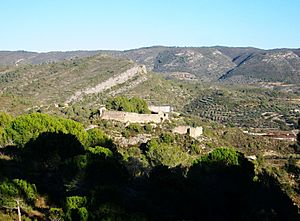Llutxent facts for kids
Quick facts for kids
Llutxent
|
||
|---|---|---|
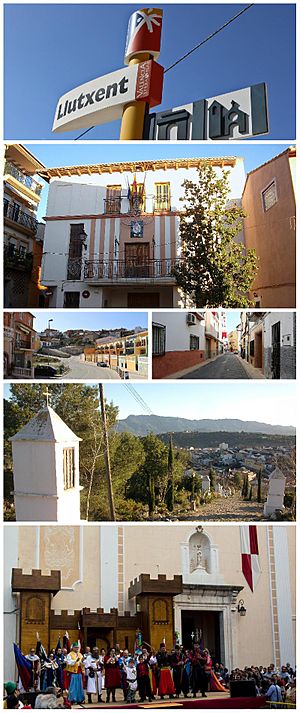
Clockwise: Llutxent's info-sign, Town hall building, Del Mig Street, View from top of The Coast, Town's Main Square during Moors and Christians, Montsant avenue
|
||
|
||
| Nickname(s):
Llutx
|
||
| Country | ||
| Autonomous community | ||
| Province | Valencia | |
| Comarca | Vall d'Albaida | |
| Judicial district | Ontinyent | |
| Area | ||
| • Total | 40.1 km2 (15.5 sq mi) | |
| Elevation | 280 m (920 ft) | |
| Population
(2018)
|
||
| • Total | 2,373 | |
| • Density | 59.18/km2 (153.27/sq mi) | |
| Demonym(s) | Llutxentine llutxentí, -ina (va) |
|
| Time zone | UTC+1 (CET) | |
| • Summer (DST) | UTC+2 (CEST) | |
| Postal code |
46838
|
|
| Official languages | Valencian and Spanish | |
Llutxent (pronounced "yoo-CHENT") is a small town in eastern Spain. It's part of the Valencian Community, a region known for its beautiful coastlines and rich history. Llutxent is about 80 kilometers (50 miles) south of the big city of Valencia and 110 kilometers (68 miles) north of Alicante. In 2016, about 2,402 people lived here.
The town's economy relies on agriculture, building work, and making things like pallets (wooden platforms for moving goods). There are also local shops and services.
Llutxent is famous for its exciting Moors and Christians festival. This celebration happens at the end of April and brings many visitors from all over the Valencian Community.
Contents
What's in a Name?
The name Llutxent comes from old Latin words. It might mean "Light Villa" or "Village of Light." This suggests it was a bright or important place long ago.
Some people think the name came from a Roman person called Lucius. In the past, Llutxent was also known by names like Luxen and Luchent. Today, people often shorten its name to Llutx.
A Look at Llutxent's History
Roman Beginnings
The very first settlement in Llutxent was started by the Romans. They built a type of farm or country house called a Roman Villa here. The town's name actually comes from this early Roman settlement. Even though the name tells us about Roman times, we haven't found many old Roman buildings or ruins yet.
Life Under Muslim Rule
We don't know a lot about Llutxent during the time it was ruled by Muslims (from 711 to 1492). The area was made up of many small farms. These farms had names like Benicia and Xetà, which are still used today to describe those parts of the town. All these farms were connected to a place called the Castle of Xiu.
Christian Reconquest
The first written records about Llutxent tell us about its reconquest by James I of Aragon. His Christian troops arrived in the area around 1229. There was a big Muslim revolt in 1247–1248. After this, King James I attacked and took over the Castle of Xiu in 1248.
He then gave the town to his Christian soldiers. This led to a permanent Christian population settling in Llutxent. However, the farms around the town still had their original Muslim residents.
In 1276, the town was badly damaged during another revolt. King James I sent more Christian troops, and they successfully took back the town. The next year, an Italian noble named Joan de Proxita was given control of Llutxent. He then created the "Barony of Llutxent."
Christian Rule Continues
Between 1348 and 1349, Llutxent saw some small battles during a war in the Crown of Aragon. The Proxita family, who were the lords of Llutxent, started building the Palace Castle. Later, in 1487, control of the town was passed to the Maçà family.
Places to Visit in Llutxent
Castles and Palaces
- Castle of Xiu: This castle was built by Muslims long ago. It was left empty after many people were forced to leave the area. Even though it needs repairs, it's still an important landmark for the town.
- Castle-Palace of Llutxent: The Proxita family built this palace between the 15th and 16th centuries. Today, the town owns it.
Religious Buildings
- Church of the Assumption: This church was built in the 1800s on top of an older church that was in ruins. It has a classic style and holds important art and historical items.
- Monastery of the Corpus Christi (The Convent): This was built by Dominican monks and was actually the first university in the Valencian region! It has been changed and added to over the years. A Gothic-style church was added in the 17th century. Next to the Monastery, you can find a Carob Tree that is over 200 years old.
- Chapel of the Consolation: Founded by pilgrims in 1772, this chapel has a Baroque style. Beautiful stained-glass windows were added to it in the 1970s.
Other Interesting Sights
- The Coast: This is a stone-paved road built in 1580. It connected the Monastery of the Corpus Christi with the town's church. People used it for religious walks between the two places.
- Farmer's Park: This park is a gathering spot where many local organizations are located.
See also
 In Spanish: Luchente para niños
In Spanish: Luchente para niños


